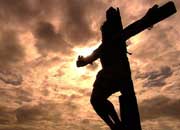Last night I finished reading “The Historical Figure of Jesus” by E. P. Sanders. I did enjoy the book – admittedly, some parts more enthusiastically than others. Some of his methodology is a little stale and he is hindered because of it. I really enjoyed his analysis of the political setting of Jesus’ life in 1st century Palestine, although I think he underestimates the Jewish perception of Roman oppression.
He’s too quick to dismiss the reliability of the confrontation scenes between Jesus and his “enemies” because of the weakness of “enemy” arguments and because of the theological arrangement of such scenes by the Gospel writers. I do think this leads Sanders to minimize the tension between Jesus and the Pharisees, which is puzzling since he ends the book with such a forceful (and, in my opinion, accurate) statement of Jesus’ self-conception of his role: Jesus regarded himself as having the right to say who would be in the Kingdom of God and he held that God was acting directly and immediately through him, bypassing the Law.
While he repeatedly states how important the Scriptures were to Jesus as a first century Jew and while he agrees that Jesus was enacting some of the Old Testament prophecies (particularly in his final week), except in a far too generalized fashion, Sanders shies away from exploring Jesus’ understanding of the Scriptures and prophetic traditions and how it influenced his conception of his ministry and mission.
This is perhaps one of the reasons Sanders makes the big mistake of rejecting the idea that Jesus understood the Kingdom of God has having a present as well as a future reality. In some places I believe he violates his own methodology in order to keep Jesus’ teachings of the Kingdom to be “at hand” and never “among you.”
Where I believe Sanders gets it very right is the reason Jesus was arrested. Namely, Jesus’ enacted parable of “cleansing the Temple” was seen and rightly understood as a prophecy predicting the Temple’s utter destruction by God.
A very well written and researched book.
 "Thinking Eternally, Acting Locally." - Neal August
"Thinking Eternally, Acting Locally." - Neal August
No comments:
Post a Comment